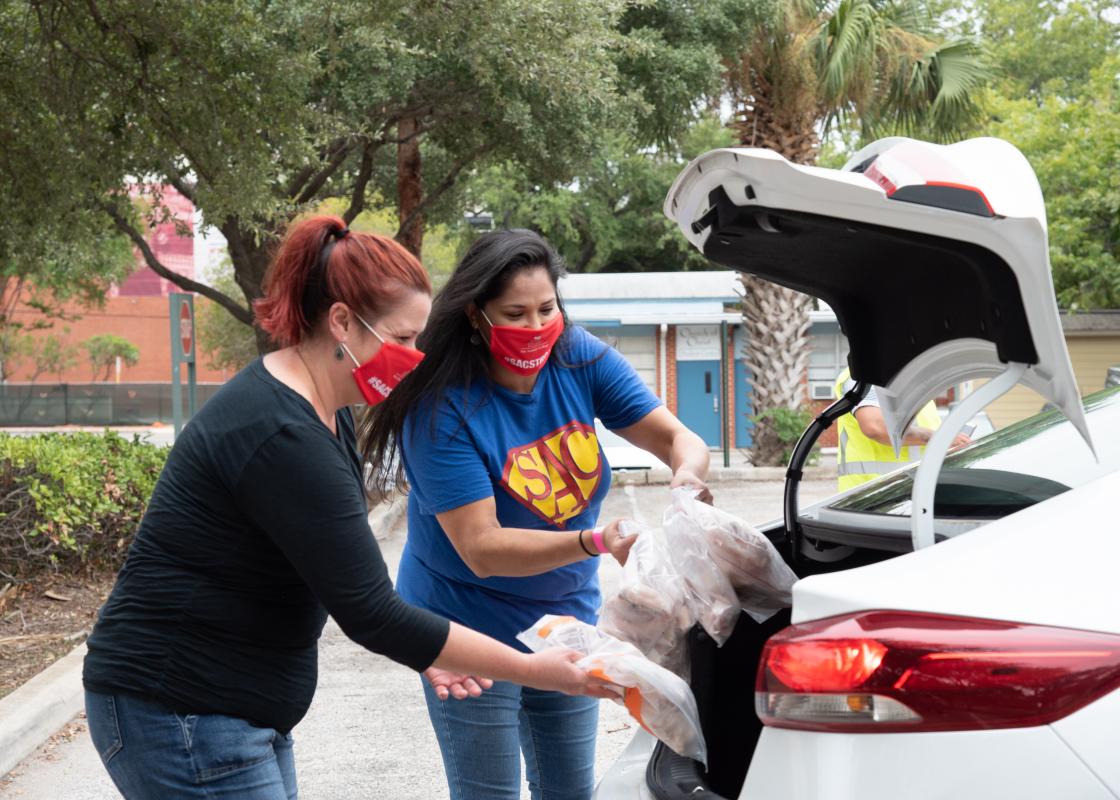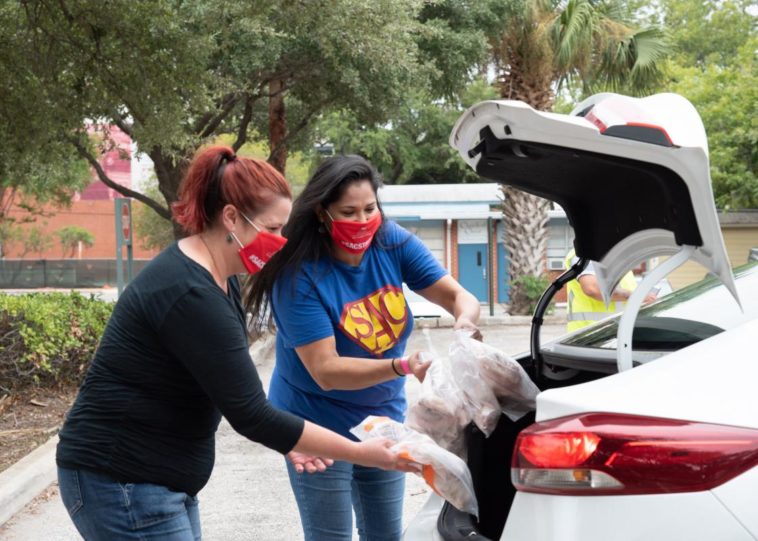Community colleges see demand for food bank services swell – Inside Higher Ed

Long Beach City College in California in 2019 provided hot breakfasts for about 1,800 students across 10 separate events. This past fall, on Nov. 24, the college provided a food pickup service to about 390 students (helping about 1,820 household members total) in one day.
San Antonio College, part of the Alamo Colleges District in Texas, provided nearly 89,000 pounds of food for 633 students (getting food for a total of 3,455 individuals) from September through December in 2020.
Calhoun Community College in Alabama disbursed 26 emergency grants from March through September 2020, more than twice the amount they usually disbursed prior to the COVID-19 pandemic.
Trident Technical College in South Carolina has more than doubled the amount of food it distributes each month since the pandemic began, from 2,000 pounds to 4,700 pounds.
The list goes on. Many community colleges across the country are working to meet a surge in demand for food and other basic necessities. Staff members who run these programs are concerned about what the future will hold if the pandemic, and thus the need, doesn’t subside soon.
Food insecurity among college students is nothing new, but the pandemic is exacerbating the problem. A survey from Chegg.org found that nearly one-third of students said they had experienced food insecurity since the coronavirus outbreak began. More than half of respondents said they have used off-campus food banks.
Swipe Out Hunger, a nonprofit focused on hunger among college students, partnered with Chegg.org for the survey. The organization works with a handful of community colleges and has seen demand for services like food banks generally increase due to the COVID-19 pandemic, said Emily Kass, community engagement manager at Swipe Out Hunger.
Community college students are more likely to be older and thus have more responsibilities, Kass said. They’re more likely than their four-year college peers to be working and parenting while taking classes.
At the same time, food banks are also struggling, Kass said. Some community food banks are seeing fewer donations as people stay home during the pandemic, and also fewer volunteers. Some have even closed, she said.
Colleges that already had on-campus food banks or similar services have been able to find ways to serve students in a remote world. But those that were just starting a program or had yet to do so are facing an uphill battle, Kass said.
“I think there’s a hesitance around creating short-term solutions for food security,” she said. “But often these short-term solutions can be a student’s lifeline.”
Short-term solutions can also be a way to get students long-term assistance. Often students will connect with staff at food banks who can help them get more financial aid or refer them to mental health professionals, Kass said. In a virtual world, some colleges have been using Zoom banners and student leaders to help advertise food bank services and encourage students to get help.
Some community colleges haven’t seen a spike in demand, though. Laurie Fladd, director of holistic supports for Achieving the Dream, said it depends on how the college is offering services and its student population. Those that kept pantries open have heard from students that they’re hesitant to come in and risk exposure, she said. Other colleges told her that students don’t have transportation access to pick up food, or they’re too busy caring for children or a family member at home to get to campus.
For others, community or K-12 resources may be more convenient. In tribal communities, for example, the community provides food assistance, not the college, Fladd said.
Dallas College in Texas has about 45,000 students who are at the poverty level, said Alex Lyda, senior director of communications. The college district’s mobile pantry has provided nearly 2.2 million pounds of food to more than 20,000 families. The district also has a grocery gift card program that has handed out nearly $75,000 to students.
Financial sustainability for these programs is also a concern.
“Community colleges are the least funded sector of higher education, but they serve the majority of students with these needs for social and academic services,” said Martha Parham, senior vice president public relations for the American Association of Community Colleges.
Higher education budgets in many states have already been slashed, and it’s yet to be seen what revenue will look like next year in states that rely on tax income. Parham expects most sectors to take a hit, but it will be especially damaging to community colleges trying to address these issues. But these programs are critical for community college students, especially in light of enrollment reports that indicate lower-income students are choosing not to go to college during this time.
“If students are hungry or don’t have a place to go home to, then certainly learning is not at the forefront of their priorities,” Parham said.
Long Beach City College has always served students with greater needs, such as those who were incarcerated or those who were in the foster care system, said Lou Anne Bynum, interim superintendent-president of the college. As many students and their family members are losing jobs or hours due to the pandemic, the need has only increased, she said.
Like many other colleges, Long Beach shifted to a drive-through food bank model. Students fill out a simple application, which doesn’t require them to demonstrate need, and show up at a specific time. They open their trunk and a staff member loads in the food. The college has started a delivery model for students who can’t get to the campus. Before the holidays, about 25 students signed up for the pilot program. Bynum said they hope to ramp up the service this spring.
“It’s all about making sure students can stay in college,” she said.
One small positive is that the stigma of using these kinds of social services is declining. The college’s staff works hard to reach out to people and destigmatize help, Bynum said.
“You can see on the news every night people who were middle class in line for miles to get food,” she said. “It’s more widespread in the community, so I don’t think there’s as big a stigma.”
The college has hired additional staff to help with these services, including five work-study students and two outreach specialists. It relies on community partners, like the local rotary club, for donations.
A $275,000 grant from the California Community Foundation let Long Beach get refrigeration units to store perishable food and distribute grocery store gift cards for the winter break. The college is also in the last year of a $700,000 grant for the College Homeless and Housing Insecure Pilot Program from the California Community Colleges chancellor’s office, which lets the college partner with community agencies to help students find housing, as well as do a campus housing feasibility study.
Bynum is optimistic that the state’s community college system and the Legislature will recognize the need for the rest of the pandemic. The bigger question is how the college helps students when COVID-19 is a thing of the past.
“Most of the needs were there before COVID,” she said. “There’s been a growing demand over the last few years for basic needs. We have to rethink the ways that we provide services, and we have to make sure we’re on point with student needs.”
Others echoed these needs. Chris Solomon is department head for accounting at Trident Technical College and an adviser to Phi Theta Kappa, the organization that runs the college’s food bank, known as the grocery vault.
The vault has received substantial cash donations throughout the pandemic, and the program seeks out grants and other funding resources. But sustainability is a big question.
“Sustainability is definitely the goal, but the reality is when the pandemic is over and food insecurities are not in the forefront, the donations will decrease to prior levels,” Solomon said.
San Antonio College has partnered with the San Antonio Food Bank to provide drive-through food banks at its campus, as well as the other Alamo Colleges campuses. Demand at both the colleges and the city has increased greatly during the pandemic, so the food bank has had to decrease the amount of food it can provide, and the college caps the number of students it can serve at each event.
So far, the college has been able to meet the demand, said Jillian Denman, director of the Student Advocacy Center. Students can still do counseling and get case management help virtually. The college has handed out grocery gift cards for the holidays, and it provided full Thanksgiving dinners to 65 students.
The college has also created a help line for the advocacy center so that students can call one number and be connected with the appropriate resources. Since it launched in March, the help line has received nearly 7,000 calls, she said.
Denman worries that, if the pandemic continues as it is, the demand might increase as those who were limping along for the last 10 months start to struggle.
“In the back of my mind, I’m always worried about the what-ifs. What if the food bank says it’s out of food?” she said.
But the college has backup funds it hasn’t needed to stock its pantry, which is closed right now, and its leadership recognizes the need. For example, instead of furloughing workers who couldn’t work remotely, the college temporarily reassigned them to help the center.
Robert Vela, president of San Antonio College, is hopeful that the second round of COVID relief funds from Congress will help community colleges continue to provide emergency aid to students. In the last round of funding, the formula counted full-time students, resulting in lower allocations for community colleges that serve many part-time students.
The college also has some funds from its local governments, private donations and grants. But it’s facing a cut in state budget appropriations that will take effect next September.
“We are bracing for that cut,” Vela said, though he doesn’t yet know how large it will be. The college is choosing to not backfill positions so it can save money now in anticipation of continued high demand for students.
“I really do believe we’ll be able to meet demand” for food, he said. “What I worry about is that extra money students may need” to pay rent or cover a bill.
Partnering with community organizations is key, said Kathryn Stremiecki, assistant vice president for student life, development and wraparound services at Ivy Tech Community College in Indiana.
The college, which serves upwards of 70,000 students, often connects students with local food pantries and other services.
“Many of our food pantries were designed to help fill short-term gaps in need as students get connected to other community services,” Stremiecki said.
When the college closed last spring, it gave students emergency aid from the federal CARES Act, as well as local referrals. Ivy Tech has had to rethink how it runs its pantries, as it can’t rely on donations from now-remote employees. Its 40 locations all do things differently, with some offering pickups for food bank resources or providing holiday food baskets. Some have kept pantries open, but with social distancing and enhanced sanitization.
Compton College in California has used several partnerships to provide food to students. It partnered with Sunrise Produce to provide 1,200 grocery boxes for pickup two times each week through December, said Keith Curry, president of the college. Uber Eats and Everytable have also partnered with the college to deliver food to students’ homes.
Published at Thu, 07 Jan 2021 08:10:52 +0000






Comments
Loading…